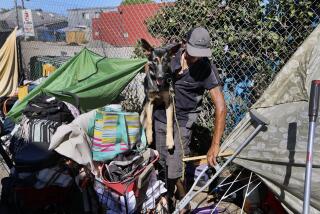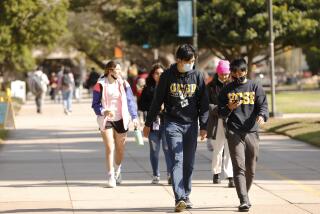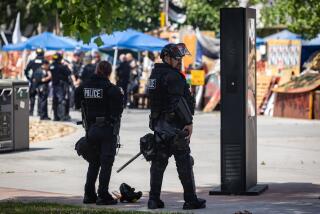To clear Occupy camp, LAPD uses new tactics
- Share via
When the end came, it came swiftly and with the shock of an overwhelming force.
Hundreds of police officers in riot gear swarmed out of Los Angeles City Hall early Wednesday, batons across their chests, surprising and engulfing the Occupy L.A. protesters who had been camped in the surrounding park for two months.
“Shame on you!” protesters shouted, as the officers ran to pre-assigned spots, instantly dividing the park into small, easily controlled segments. “Get back!” police shouted to those who came too close.
“We are peaceful!” protesters yelled.
The operation began at 12:13 a.m., on orders from Deputy Chief Jose Perez, watching from the steps of Los Angeles police headquarters across the street.
Two minutes later, it was effectively over.
Although police spent hours more arresting protesters and clearing the area, there was never a fight for control of the park. Police made sure that was not really a question. And although a few protesters threw rocks or otherwise resisted, most kept their cool and urged their compatriots to do the same.
Through a combination of effective tactics, daunting numbers and — significantly — restraint by both sides, police managed to bring the encampment to a largely peaceful end, avoiding the melees that marred the eviction of protesters from similar camps in Oakland, New York and elsewhere.
In the process, the LAPD took a major step toward shedding a reputation earned over decades for heavy-handed crowd control.
“The LAPD had their A game on,” said Pam Noles, an Occupy protester and legal observer with the National Lawyers Guild. “I was really proud of the Occupiers who stood on message, stood on discipline and stood on faith,” she added. “Both sides did what they had to do.”
Both protesters and police knew the end of the camp was near. Both had planned for the inevitable confrontation for weeks.
Modeled after the Occupy Wall Street protest in New York, L.A.’s camp began Oct. 1, part of a loosely organized national movement that has decried the gap between rich and poor in America and the influence of corporate capitalism on the political system. Within a short time, hundreds of people were camped in the 1.7-acre park.
Protesters received a relatively warm welcome, with the City Council endorsing their action and council President Eric Garcetti inviting them to stay as long as they liked. But as days rolled into weeks and months, Mayor Antonio Villaraigosa and other city leaders began showing signs of impatience with rising costs, petty crime and property damage. Ultimately, Villaraigosa, saying he feared for the safety of children at the camp, ordered the protesters to leave. They refused.
At LAPD headquarters, meetings to plan how to clear the camp began about three weeks ago.
Police Chief Charlie Beck, Assistant Chief Earl Paysinger and others were certain that traditional approaches wouldn’t work.
The accepted wisdom of crowd control that police have adhered to for decades called for a long, single line of officers to sweep through the grounds and push out protesters. That tactic was used in a costly 2007 debacle clearing a protest at MacArthur Park.
Police officials shuddered at the thought of employing that technique on the sloped, tree-filled lawns of City Hall that were covered with scores of tents. And while it might push protesters out of the park, it would not have given police control over how they dispersed, the officials said.
“We knew we didn’t want to just push them out,” Beck said. “The last thing we wanted was to be chasing them through the streets.”
Beck had dispatched officers to Oakland after police there clashed violently with protesters while trying to clear the city’s Occupy camp. Oakland officers told their LAPD counterparts that trouble had started in part because protesters had been able to come together in a large group that emboldened them.
L.A. police wanted a plan that would divide and isolate protesters. The park seemed to lend itself to such an idea, with broad brick pathways that broke the lawn into sections.
Lt. Joseph McWilliams of the elite Metropolitan Division oversaw a team of officers tasked with drawing up a plan. Paysinger called McWilliams “one of the brightest tacticians we have.” The rough outline for the plan came together in days. On Monday last week, Metro officers briefed Paysinger, giving him a Power Point presentation on how it would play out.
“When I saw the architecture of what they had come up with, I knew it was one of the best tactically designed ideas I had seen in decades, and that’s not overstating it,” Paysinger said. “It was totally different and much more precise” than anything the LAPD had ever tried before, he added.
Police planners worked off the strong belief that the protesters would remain largely peaceful when officers stormed the park. From the outset, department officials had struck a collaborative, friendly stance with protesters, and believed they knew what to expect from them. Time would prove them right.
A core group of demonstrators, meanwhile, had spent weeks training for nonviolent civil disobedience. The Occupy camp was intentionally non-hierarchical, and included elements who might have been inclined toward violence, but it had largely succeeded in instilling a nonviolent ethos.
On Tuesday night, two hours before police moved in, several dozen protesters wound themselves into a tight circle and sat around a tent, arms linked.
Police, meanwhile, began gathering at the Dodger Stadium parking lot about 8 p.m. As midnight approached, they boarded a fleet of MTA buses for the short drive from the stadium to City Hall East, a building across the street and largely out of view of the protesters.
As buses pulled up, many officers hurriedly made their way into the building. Using underground tunnels and a second-floor breezeway, they flooded into City Hall and took up positions. Most lined up inside the doors at the top of a staircase that led down to the south lawn. Eventually, there were 500 officers inside. Others gathered outside.
A sour smell wafted through the park, covering the odor of waste and perspiration. Protesters were dousing rags in vinegar, which is known to counteract tear gas.
Meanwhile, several dozen protesters left the camp and filled the intersection of Main and 1st streets, adjacent to City Hall, chanting “Whose streets? Our streets!”
Police officials took advantage of the moment, making a deliberate show of officers to draw protesters attention away from City Hall. When the order came, the park turned almost instantly to a sea of blue, dotted with officers in white hazardous material suits who were charged with searching those arrested.
“They were like storm troopers,” said protester Cheryl Aichele.
Legal observers and clergy were circulating amid the chaos, invited by the LAPD to observe and help defuse tensions.
Rabbi Jonathan Klein, who has been involved in the protest since October and who met with Villaraigosa to call for police restraint, was there all night, cheering protesters who cooperated with police. Klein said many protesters were saddened by the end of the camp, feeling that their objectives had not been realized. Building social movements “is not a simple process,” he said. “Deep democracy takes time.”
Though the initial rush of police was tense and chaotic — police moved quickly, flinging away barricades that protesters had set up to keep them out — the mood quickly eased. After police slashed through tents and got a count of all of the protesters in the park, they worked slowly and methodically to arrest them.
It was after 4 a.m. when the last, tree-sitting protester was removed. In all, 292 would go to jail. There were no significant injuries reported, though one tree-sitter was shot with a bean bag when he allegedly resisted arrest. A few protesters said police used excessive force.
By 7 a.m., city crews were surveying the damage and erecting fences and concrete barriers around the block. Villaraigosa promised a full accounting of city costs incurred by the camp, estimating the total could exceed $1 million. But Beck said much of cost of the eviction would come from private funds collected by the LAPD for policing at Michael Jackson’s memorial.
Connie Rice, a civil rights attorney and longtime LAPD observer, said the handling of the protest was a milestone for the department. “You have to agree that this is not your grandfather’s LAPD.”
FULL COVERAGE: Occupy Los Angeles
The following Times staff writers contributed to coverage of Occupy L.A.:
Andrew Blankstein, Howard Blume, Armand Emamdjomeh, John Hoeffel. Mitchell Landsberg, Alejandro Lazo, Rong-Gong Lin II, Kate Linthicum, Ricardo Lopez, Robert J. Lopez, Sam Quinones, Rick Rojas, Joel Rubin, Nicole Santa Cruz, Abby Sewell, Jason Song, Carol J. Williams, Richard Winton and David Zahniser
More to Read
Sign up for Essential California
The most important California stories and recommendations in your inbox every morning.
You may occasionally receive promotional content from the Los Angeles Times.











